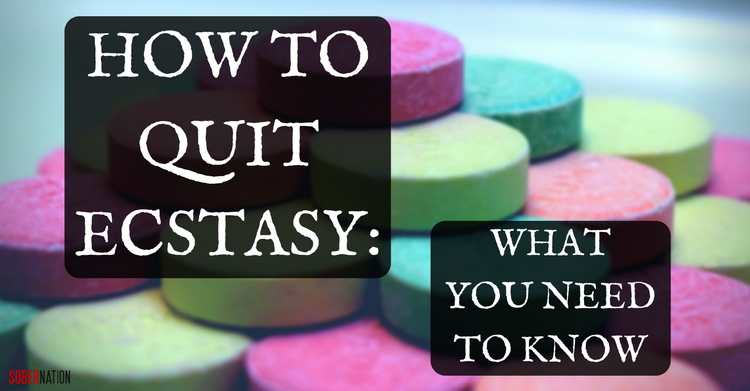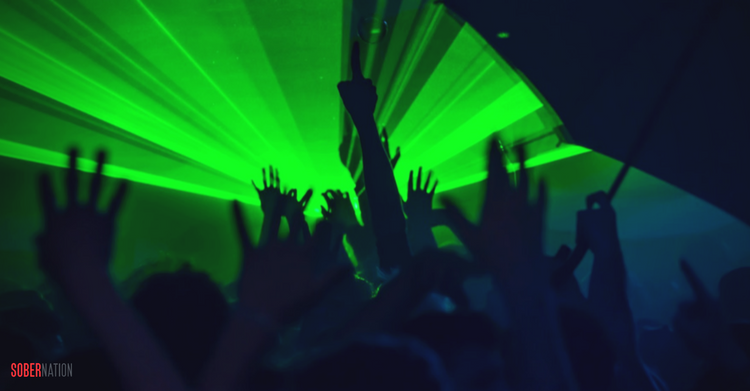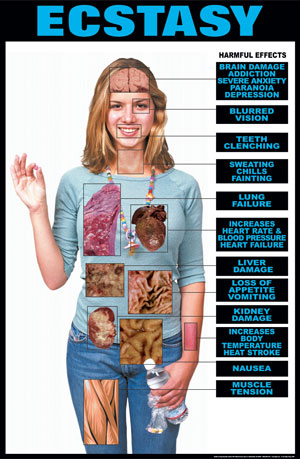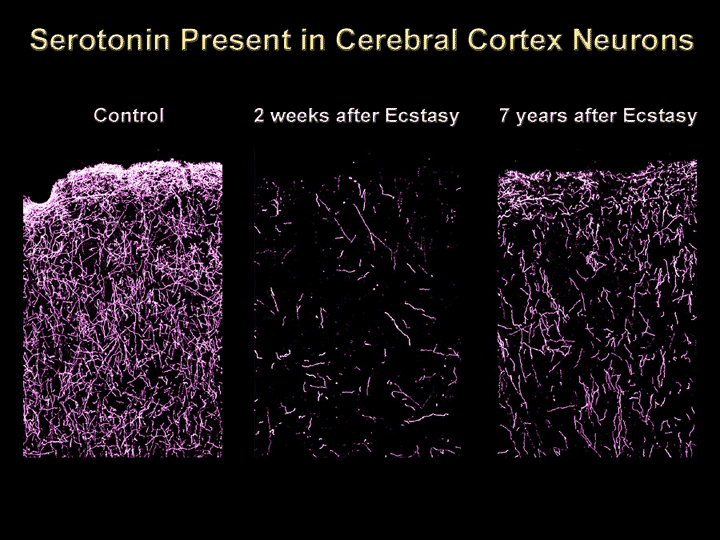Jan 28, 2013 | By Tim Stoddart
How to Quit Ecstasy: What You Need to Know
Ecstasy Addiction
Ecstasy refers to the chemical MDMA, which is both a psychedelic drug and a stimulant. It’s also referred to as E, Molly, X, a Disco Biscuit, or the Hug Drug. Ecstasy tablets are typically called “Beans,” and taking the drug is known as “rolling.”
As the name implies, Ecstasy is associated with the feelings of euphoria, love, and pleasure that it can produce. It’s a “club drug” that became popular in the 80s and 90s at raves and nightclubs. Today, it’s still a common drug of abuse at concerts, parties, and music festivals. In 2014, over 600,000 people over the age of 12 were current Ecstasy users in the United States.
The Difference Between Ecstasy and MDMA
True MDMA is a synthetic chemical that’s made in a lab. An amphetamine derivative, it’s structurally similar to the stimulant methamphetamine and the hallucinogen mescaline. “Pure” MDMA can come in powder, crystal, or liquid form. It’s often snorted or put into capsules and ingested, though there are rare cases of users injecting MDMA.
It has most notably been studied by “psychedelic researchers” in the past, and more recently by psychotherapists as a treatment for Post-Traumatic Stress Disorder (PTSD). The perception that MDMA is a “therapeutic” drug has led many users to believe that it’s relatively safe.
But, Ecstasy and Molly are names for a drug that’s supposed to be purely MDMA. However, according to the DEA, what dealers and users refer to as Ecstasy, Molly, or even “pure” MDMA very rarely contains any MDMA at all. Frequently, MDMA is cut with or replaced by:
- methamphetamine
- ketamine
- cocaine
- ephedrine
- caffeine
- bath salts
What’s referred to as Ecstasy is most often found in the form of colorful pills, tablets, or candies that are typically snorted or ingested. These pills are generally a combination of dangerous substances, unknown to the user, which makes every dose a gamble.
Even more dangerous is the culture of using that surrounds Ecstasy, which embraces “stacking” doses on top of one another and then mixing those high doses with other drugs. Although it’s less physically-addicting than other drugs like cocaine or heroin, frequent Ecstasy users can absolutely develop a psychological dependence on the drug.

Effects of Ecstasy on the Brain
Ecstasy is a popular drug of abuse because of its well-known effects:
- lasting and intense surge of energy
- feelings of confidence, decreased anxiety
- general sense of well-being
- sense of closeness, increased empathy
- enhanced sense of touch
- distortions in time
- heightened sexuality
MDMA induces these effects by causing your brain to release powerful neurotransmitters: serotonin, dopamine, and norepinephrine. These neurotransmitters affect your mood, energy, sleep, appetite, trust, sexual arousal, and sociability. In combination, they bring a surge of pleasure that’s both emotional and physical. Some refer to rolling on Ecstasy as something “spiritual.”
But, that immense surge of chemicals caused by MDMA depletes your brain of them. That initial rush of good feelings will lead to an unpleasant crash later. With repeated and chronic use, Ecstasy can have serious psychological effects and lead to withdrawal. Ultimately, the greatest danger with frequent use is the huge risk inherent in every dose, because the chemical composition of each Ecstasy tablet is so variable.
Effects of Ecstasy on the Body
Physically, Ecstasy use comes with a host of adverse effects:
- dehydration and extreme thirst
- jaw clenching, teeth grinding
- muscle cramping, tension
- tremors
- blurred vision
- nausea
- insomnia
- increased heart rate
- elevated blood pressure
- faintness, loss of consciousness
- inability to regulate temperature—can lead body to overheat
MDMA reduces the heart’s ability to pump blood and dehydrates the body, making the drug even more difficult to metabolize. This quickly leads to toxic levels in the bloodstream. Though Ecstasy is often considered “harmless” in comparison to other hard drugs, it has an extremely high potential for overdose.
Because the drug is commonly associated with the club and concert scene, users are often taking high doses and moving or dancing rigorously. This can lead to hyperthermia—a sharp increase in body temperature that requires medical attention. Hyperthermia is characteristic of Ecstasy overdose, which can be fatal when it leads to heat stroke, muscle breakdown, kidney failure, or heart failure.
Symptoms of Ecstasy Withdrawal
When a user tries to quit Ecstasy, withdrawal symptoms can range from mild to severe depending on their history of usage and dosage. Even with just one dose, a user experiences a “come-down” shortly after the effects of Ecstasy wear off. Ecstasy abuse creates huge surges of neurotransmitters in the brain, which will eventually wane.

The come-down is more intense after a large dose or repeated doses. It can produce symptoms like:
- sadness or depression (as serotonin levels drop)
- confusion
- anxiety
- fatigue
- restlessness
- irritability
- aggression
People who quit Ecstasy after abusing the drug on a regular basis can also experience more extreme withdrawal symptoms:
- prolonged depression or anxiety
- sleeplessness and insomnia
- panic attacks
- paranoid delusions
- hallucinations
- difficulty concentrating
- memory and thought problems
How to Quit Ecstasy
If you want to quit Ecstasy, the best way to begin the recovery process is in a medical detoxification center. At a detox facility, medical professionals can supervise you and prescribe medication to help you deal with the withdrawal symptoms.
Detox is a crucial step for your health and the wellness of your body, but it won’t help you quit Ecstasy in the long-term.
The Importance of Treatment
After detox, a stay in an inpatient rehab center is also recommended. If you or a loved one is addicted to MDMA, you’ll benefit from being in a safe, controlled environment.
True recovery involves confronting the underlying causes of your Ecstasy abuse and addiction. In treatment, you’ll have the chance to learn new skills that can help you manage cravings, as well as cope with troublesome thoughts and feelings. Through addiction therapy in both individual and group settings, you’ll work alongside treatment professionals to build a new, healthier life without Ecstasy.
In treatment, counselors will help you in a wide range of areas that might affect your Ecstasy abuse:
- family relationships and dysfunction
- co-occurring mental illness
- past trauma or emotional wounds
- accompanying behavioral disorders
- relapse triggers—thoughts, emotions, places, people
Treatment can help you learn to live without Ecstasy, and your future is far from a “doomsday.” You can build a life of fulfillment that you actually enjoy more, without all of the pain and hassle caused by Ecstasy.
Life After Treatment
A good treatment center will help you build a strong recovery support network, which you can incorporate into your own life after treatment. Many facilities follow the 12-step philosophy of groups like Alcoholics Anonymous and Narcotics Anonymous, but there are plenty of non-12-step treatment options as well. Whatever suits you, support is crucial in maintaining long-term recovery.
Once inpatient treatment ends, quality after-care can improve your chances at long-term sobriety. Look into sober living environments, find a therapist to see regularly, enroll in outpatient treatment, or sign up for case-monitoring services.
Some people may need psychiatric care for some time after they quit Ecstasy, and they may be prescribed drugs, like antidepressants, for short or long periods of time to help them cope with lasting effects of their ecstasy use and withdrawal. Recovery is a process that grows stronger over time. The more you can do to build a strong foundation, the better.
Can’t I Quit On My Own?
If you choose to quit Ecstasy on your own, it’s always recommended that you talk to your doctor first. Create a plan to quit Ecstasy safely and successfully. If you have a sincere desire to change, hold yourself accountable for your actions. There may be friends, places, and activities that you associate with Ecstasy abuse, which will need to make way for your new life.
Whether you try to quit Ecstasy alone or seek help through addiction treatment, long-term care is necessary. Counseling, support groups, and serious lifestyle changes will help you maintain abstinence.

Rox
11 years ago
I never thought quiting would be hard, I always thought “I can quit Im not addicted” Well atleast I felt like I wasn’t addicted but I was, I just stopped 2 weeks ago and Im so anxious and panicky I feel confused and drowsie, it’s a really weird scary feeling but Hopefully I’ll get through it and im drug free for life !!!
zubair qureshi
10 years ago
I’m adik mdma please help me
Recent Articles
Xanax Abuse: Warning Signs & Symptoms Of Xanax Addiction And Abuse
Warning Signs of a Drug Relapse: Spot Them Early
How to Quit Cocaine: Overcoming Addiction & Withdrawal Symptoms
Non 12 Step Fellowships for Flexible Recovery
What are 12-Step Programs? Explore Their Principles and Impact?
Question About Treatment
Get Confidential help 24/7
(866) 207-7436Who Answers